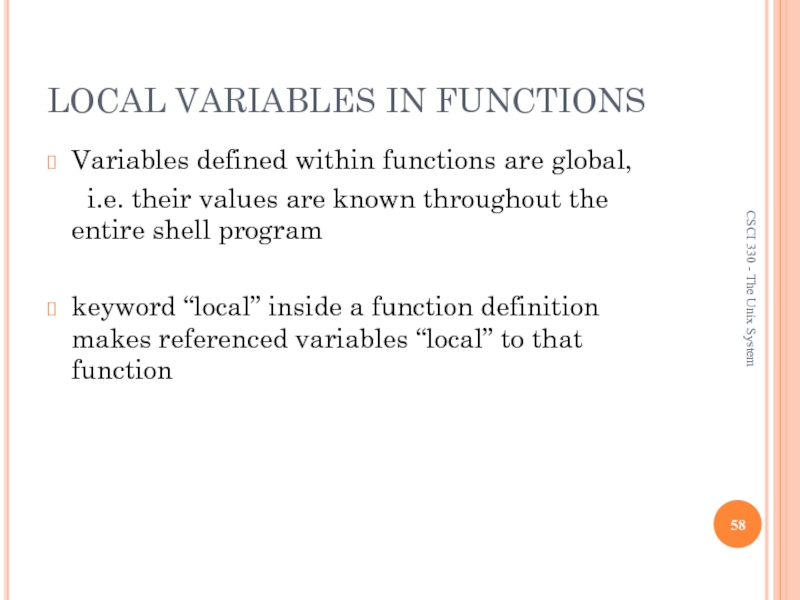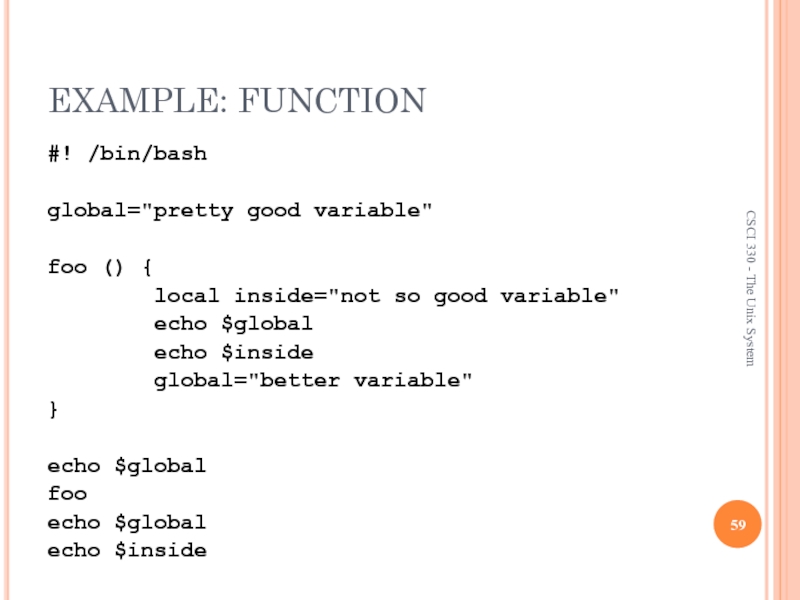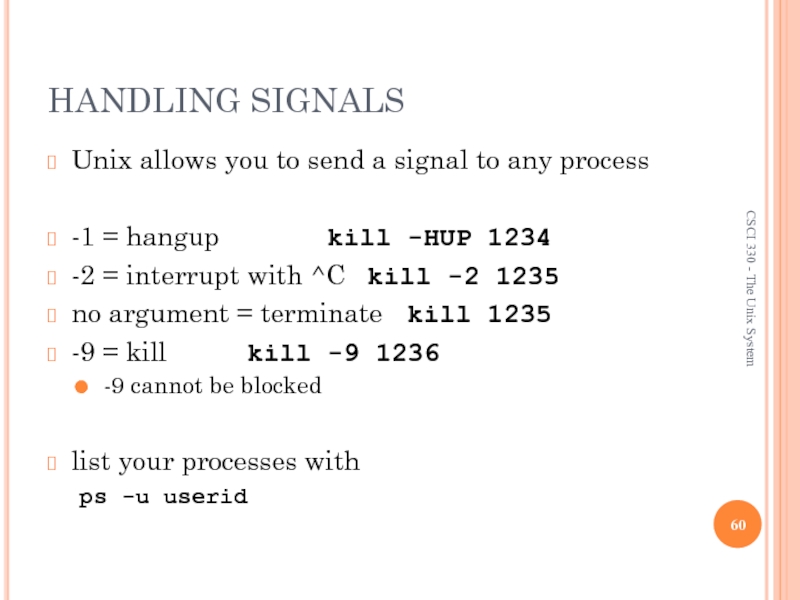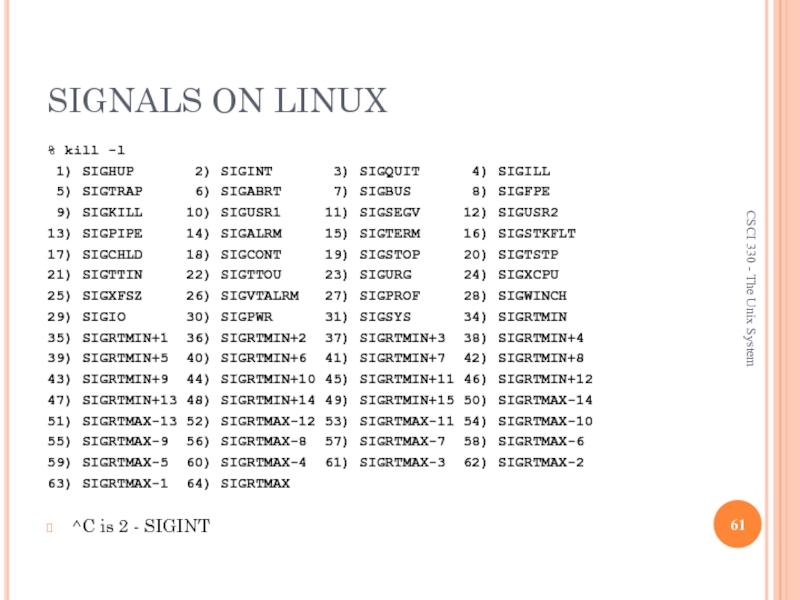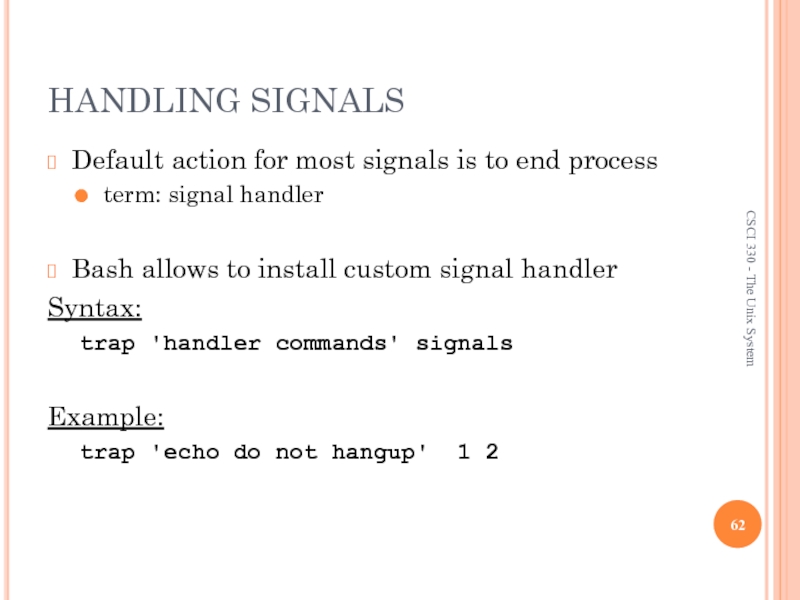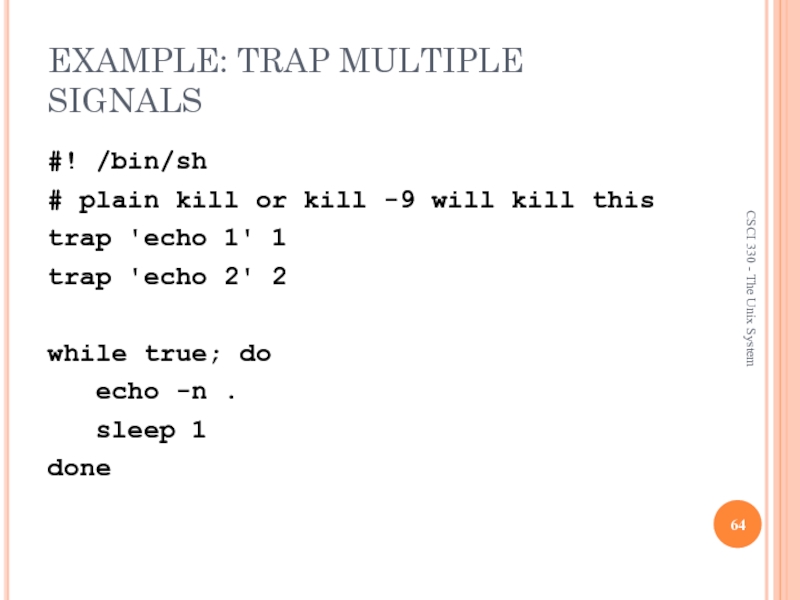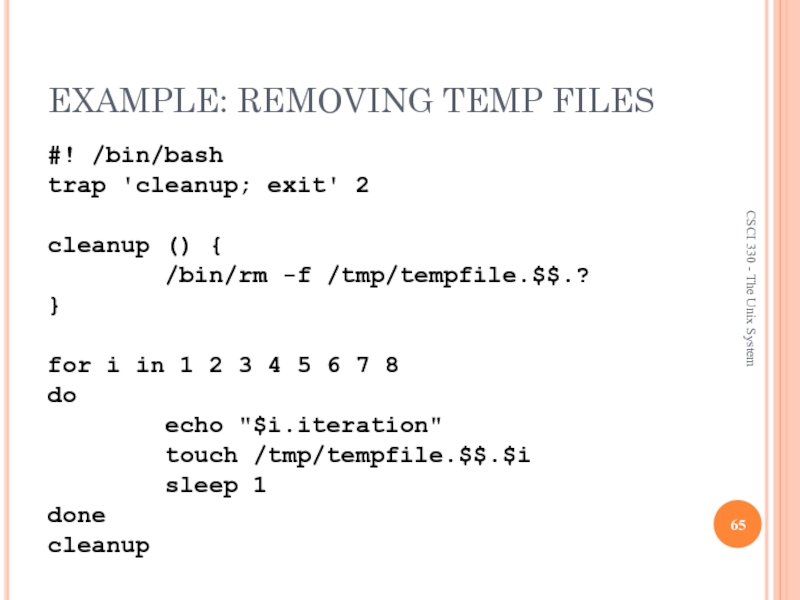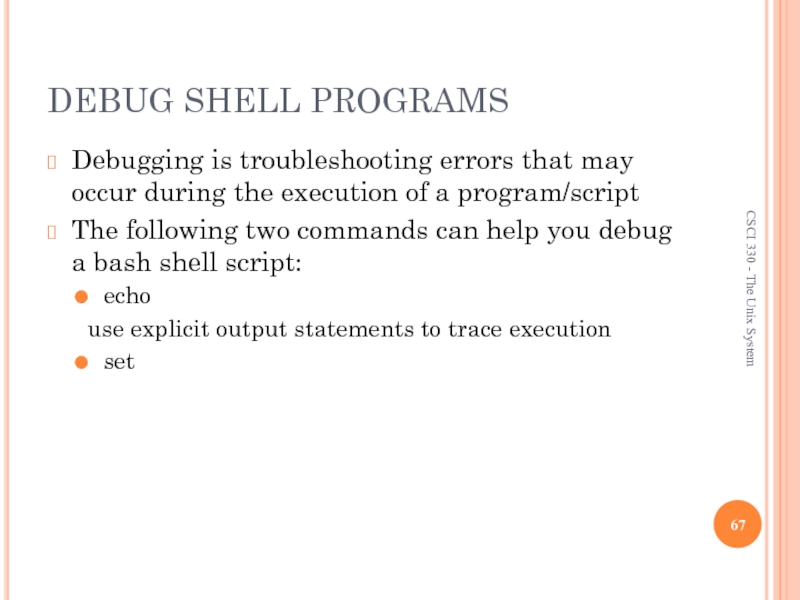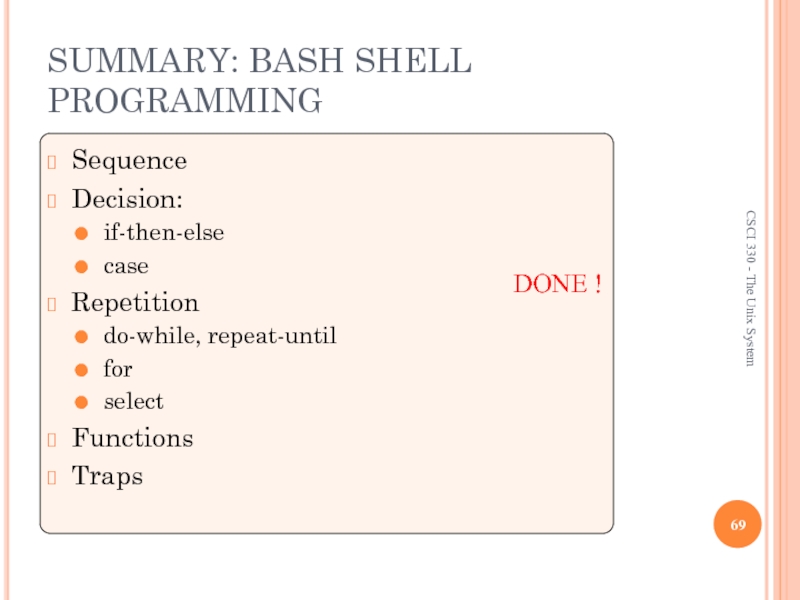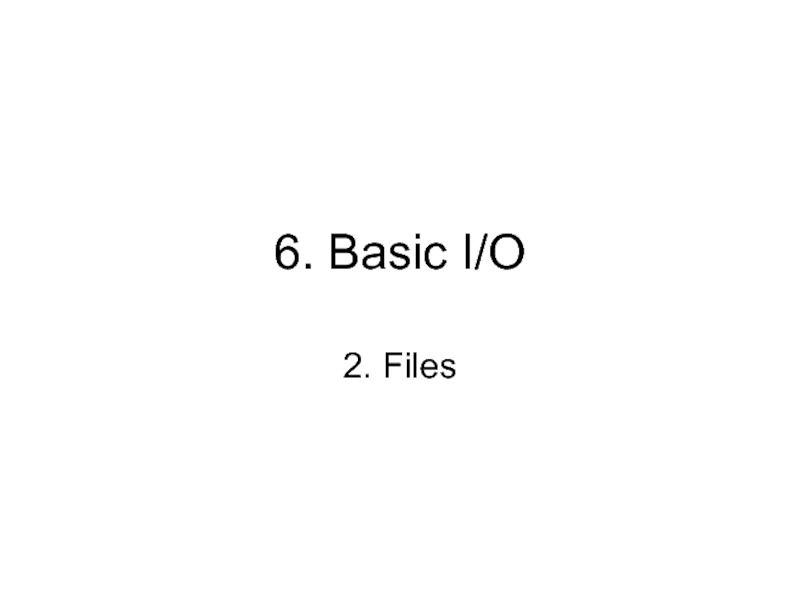- Главная
- Разное
- Дизайн
- Бизнес и предпринимательство
- Аналитика
- Образование
- Развлечения
- Красота и здоровье
- Финансы
- Государство
- Путешествия
- Спорт
- Недвижимость
- Армия
- Графика
- Культурология
- Еда и кулинария
- Лингвистика
- Английский язык
- Астрономия
- Алгебра
- Биология
- География
- Детские презентации
- Информатика
- История
- Литература
- Маркетинг
- Математика
- Медицина
- Менеджмент
- Музыка
- МХК
- Немецкий язык
- ОБЖ
- Обществознание
- Окружающий мир
- Педагогика
- Русский язык
- Технология
- Физика
- Философия
- Химия
- Шаблоны, картинки для презентаций
- Экология
- Экономика
- Юриспруденция
Bash programming. CSCI 330 the unix system презентация
Содержание
- 1. Bash programming. CSCI 330 the unix system
- 2. BASIC SHELL PROGRAMMING A script is a
- 3. BASH SHELL PROGRAMMING Input prompting user command
- 4. USER INPUT shell allows to prompt for
- 5. USER INPUT EXAMPLE #! /bin/sh read -p
- 6. SPECIAL SHELL VARIABLES CSCI 330 - The Unix System
- 7. EXAMPLES: COMMAND LINE ARGUMENTS % set tim
- 8. BASH CONTROL STRUCTURES if-then-else case loops for
- 9. IF STATEMENT if command then statements fi
- 10. TEST COMMAND Syntax: test expression [
- 11. THE SIMPLE IF STATEMENT if [ condition
- 12. THE IF-THEN-ELSE STATEMENT if [ condition ];
- 13. THE IF…STATEMENT if [ condition ]; then
- 14. RELATIONAL OPERATORS CSCI 330 - The Unix System
- 15. COMPOUND LOGICAL EXPRESSIONS ! not && and
- 16. EXAMPLE: USING THE ! OPERATOR #!/bin/bash
- 17. EXAMPLE: USING THE && OPERATOR #!/bin/bash
- 18. EXAMPLE: USING THE || OPERATOR #!/bin/bash
- 19. FILE TESTING Meaning -d file True if
- 20. EXAMPLE: FILE TESTING #!/bin/bash echo "Enter a
- 21. EXAMPLE: FILE TESTING #! /bin/bash if
- 22. EXAMPLE: IF… STATEMENT # The following THREE
- 23. EXAMPLE: IF..ELIF... STATEMENT #!/bin/bash read -p
- 24. THE CASE STATEMENT use the case statement
- 25. CASE PATTERN checked against word for match
- 26. EXAMPLE 1: THE CASE STATEMENT #!/bin/bash echo
- 27. EXAMPLE 2: THE CASE STATEMENT #!/bin/bash ChildRate=3
- 28. BASH PROGRAMMING: SO FAR Data structure Variables
- 29. BASH PROGRAMMING: STILL TO COME Control
- 30. REPETITION CONSTRUCTS CSCI 330 - The Unix System
- 31. THE WHILE LOOP Purpose: To execute commands
- 32. EXAMPLE: USING THE WHILE LOOP #!/bin/bash
- 33. EXAMPLE: USING THE WHILE LOOP #!/bin/bash
- 34. EXAMPLE: USING THE WHILE LOOP #!/bin/bash
- 35. THE UNTIL LOOP Purpose: To execute commands
- 36. EXAMPLE: USING THE UNTIL LOOP #!/bin/bash
- 37. EXAMPLE: USING THE UNTIL LOOP #!/bin/bash
- 38. THE FOR LOOP Purpose: To execute
- 39. EXAMPLE 1: THE FOR LOOP #!/bin/bash
- 40. EXAMPLE 2: USING THE FOR LOOP #!/bin/bash
- 41. LOOPING OVER ARGUMENTS simplest form will iterate
- 42. SELECT COMMAND Constructs simple menu from word
- 43. SELECT EXAMPLE #! /bin/bash select var in
- 44. SELECT DETAIL PS3 is select sub-prompt $REPLY
- 45. SELECT EXAMPLE #!/bin/bash echo "script to make
- 46. BREAK AND CONTINUE Interrupt for, while
- 47. THE BREAK COMMAND while [ condition ]
- 48. THE CONTINUE COMMAND while [ condition ]
- 49. EXAMPLE: for index in 1 2 3
- 50. DONE
- 51. SHELL FUNCTIONS A shell function is similar
- 52. SHELL FUNCTIONS must be defined before they
- 53. EXAMPLE: FUNCTION #!/bin/bash funky ()
- 54. EXAMPLE: FUNCTION #!/bin/bash fun () { #
- 55. FUNCTION PARAMETERS Need not be declared Arguments
- 56. EXAMPLE: FUNCTION WITH PARAMETER #! /bin/sh testfile()
- 57. EXAMPLE: FUNCTION WITH PARAMETERS #! /bin/bash checkfile()
- 58. LOCAL VARIABLES IN FUNCTIONS Variables defined within
- 59. EXAMPLE: FUNCTION #! /bin/bash global="pretty good
- 60. HANDLING SIGNALS Unix allows you to send
- 61. SIGNALS ON LINUX % kill -l
- 62. HANDLING SIGNALS Default action for most signals
- 63. EXAMPLE: TRAP HANGUP #! /bin/bash # kill
- 64. EXAMPLE: TRAP MULTIPLE SIGNALS #! /bin/sh #
- 65. EXAMPLE: REMOVING TEMP FILES #! /bin/bash trap
- 66. RESTORING DEFAULT HANDLERS trap without a command
- 67. DEBUG SHELL PROGRAMS Debugging is troubleshooting errors
- 68. DEBUGGING USING “SET” The “set” command is
- 69. DONE
Слайд 2BASIC SHELL PROGRAMMING
A script is a file that contains shell commands
data
control structure: sequence, decision, loop
Shebang line for bash shell script:
#! /bin/bash
#! /bin/sh
to run:
make executable: % chmod +x script
invoke via: % ./script
CSCI 330 - The Unix System
Слайд 3BASH SHELL PROGRAMMING
Input
prompting user
command line arguments
Decision:
if-then-else
case
Repetition
do-while, repeat-until
for
select
Functions
Traps
CSCI 330 - The
Слайд 4USER INPUT
shell allows to prompt for user input
Syntax:
read varname [more vars]
or
read
words entered by user are assigned to
varname and “more vars”
last variable gets rest of input line
CSCI 330 - The Unix System
Слайд 5USER INPUT EXAMPLE
#! /bin/sh
read -p "enter your name: " first last
echo
echo "Last name: $last"
CSCI 330 - The Unix System
Слайд 7EXAMPLES: COMMAND LINE ARGUMENTS
% set tim bill ann fred
% echo $*
tim bill ann fred
% echo $#
4
% echo $1
tim
% echo $3 $4
ann fred
CSCI 330 - The Unix System
The ‘set’ command can be used to assign values to positional parameters
Слайд 9IF STATEMENT
if command
then
statements
fi
statements are executed only if command succeeds, i.e. has
CSCI 330 - The Unix System
Слайд 10TEST COMMAND
Syntax:
test expression
[ expression ]
evaluates ‘expression’ and returns true or
Example:
if test –w "$1"
then
echo "file $1 is write-able"
fi
CSCI 330 - The Unix System
Слайд 11THE SIMPLE IF STATEMENT
if [ condition ]; then
statements
fi
executes the statements only
CSCI 330 - The Unix System
Слайд 12THE IF-THEN-ELSE STATEMENT
if [ condition ]; then
statements-1
else
statements-2
fi
executes statements-1 if condition
executes statements-2 if condition is false
CSCI 330 - The Unix System
Слайд 13THE IF…STATEMENT
if [ condition ]; then
statements
elif [ condition ]; then
statement
else
statements
fi
The word elif stands for “else if”
It is part of the if statement and cannot be used by itself
CSCI 330 - The Unix System
Слайд 15COMPOUND LOGICAL EXPRESSIONS
! not
&& and
|| or
CSCI 330 - The Unix System
and, or
must be
[[ ]]
Слайд 16EXAMPLE: USING THE ! OPERATOR
#!/bin/bash
read -p "Enter years of work: "
if [ ! "$Years" -lt 20 ]; then
echo "You can retire now."
else
echo "You need 20+ years to retire"
fi
CSCI 330 - The Unix System
Слайд 17EXAMPLE: USING THE && OPERATOR
#!/bin/bash
Bonus=500
read -p "Enter Status: " Status
read
if [[ "$Status" = "H" && "$Shift" = 3 ]]
then
echo "shift $Shift gets \$$Bonus bonus"
else
echo "only hourly workers in"
echo "shift 3 get a bonus"
fi
CSCI 330 - The Unix System
Слайд 18EXAMPLE: USING THE || OPERATOR
#!/bin/bash
read -p "Enter calls handled:" CHandle
read -p
if [[ "$CHandle" -gt 150 || "$CClose" -gt 50 ]]
then
echo "You are entitled to a bonus"
else
echo "You get a bonus if the calls"
echo "handled exceeds 150 or"
echo "calls closed exceeds 50"
fi
CSCI 330 - The Unix System
Слайд 19FILE TESTING
Meaning
-d file True if ‘file’ is a directory
-f file True if
-r file True if ‘file’ is readable
-w file True if ‘file’ is writable
-x file True if ‘file’ is executable
-s file True if length of ‘file’ is nonzero
CSCI 330 - The Unix System
Слайд 20EXAMPLE: FILE TESTING
#!/bin/bash
echo "Enter a filename: "
read filename
if [ ! –r
then
echo "File is not read-able"
exit 1
fi
CSCI 330 - The Unix System
Слайд 21EXAMPLE: FILE TESTING
#! /bin/bash
if [ $# -lt 1 ]; then
exit 1
fi
if [[ ! -f "$1" || ! -r "$1" || ! -w "$1" ]]
then
echo "File $1 is not accessible"
exit 1
fi
CSCI 330 - The Unix System
Слайд 22EXAMPLE: IF… STATEMENT
# The following THREE if-conditions produce the same result
*
read -p "Do you want to continue?" reply
if [[ $reply = "y" ]]; then
echo "You entered " $reply
fi
* SINGLE SQUARE BRACKETS
read -p "Do you want to continue?" reply
if [ $reply = "y" ]; then
echo "You entered " $reply
fi
* "TEST" COMMAND
read -p "Do you want to continue?" reply
if test $reply = "y"; then
echo "You entered " $reply
fi
CSCI 330 - The Unix System
Слайд 23EXAMPLE: IF..ELIF... STATEMENT
#!/bin/bash
read -p "Enter Income Amount: " Income
read -p "Enter
let Net=$Income-$Expense
if [ "$Net" -eq "0" ]; then
echo "Income and Expenses are equal - breakeven."
elif [ "$Net" -gt "0" ]; then
echo "Profit of: " $Net
else
echo "Loss of: " $Net
fi
CSCI 330 - The Unix System
Слайд 24THE CASE STATEMENT
use the case statement for a decision that is
Syntax:
case word in
pattern1) command-list1
;;
pattern2) command-list2
;;
patternN) command-listN
;;
esac
CSCI 330 - The Unix System
Слайд 25CASE PATTERN
checked against word for match
may also contain:
*
?
[ … ]
[:class:]
multiple patterns
|
CSCI 330 - The Unix System
Слайд 26EXAMPLE 1: THE CASE STATEMENT
#!/bin/bash
echo "Enter Y to see all files
echo "Enter N to see all non-hidden files"
echo "Enter q to quit"
read -p "Enter your choice: " reply
case $reply in
Y|YES) echo "Displaying all (really…) files"
ls -a ;;
N|NO) echo "Display all non-hidden files..."
ls ;;
Q) exit 0 ;;
*) echo "Invalid choice!"; exit 1 ;;
esac
CSCI 330 - The Unix System
Слайд 27EXAMPLE 2: THE CASE STATEMENT
#!/bin/bash
ChildRate=3
AdultRate=10
SeniorRate=7
read -p "Enter your age: " age
case
[1-9]|[1][0-2]) # child, if age 12 and younger
echo "your rate is" '$'"$ChildRate.00" ;;
# adult, if age is between 13 and 59 inclusive
[1][3-9]|[2-5][0-9])
echo "your rate is" '$'"$AdultRate.00" ;;
[6-9][0-9]) # senior, if age is 60+
echo "your rate is" '$'"$SeniorRate.00" ;;
esac
CSCI 330 - The Unix System
Слайд 28BASH PROGRAMMING: SO FAR
Data structure
Variables
Numeric variables
Arrays
User input
Control structures
if-then-else
case
CSCI 330 - The
Слайд 29BASH PROGRAMMING: STILL TO COME
Control structures
Repetition
do-while, repeat-until
for
select
Functions
Trapping signals
CSCI 330 - The
Слайд 31THE WHILE LOOP
Purpose:
To execute commands in “command-list” as long as “expression”
Syntax:
while [ expression ]
do
command-list
done
CSCI 330 - The Unix System
Слайд 32EXAMPLE: USING THE WHILE LOOP
#!/bin/bash
COUNTER=0
while [ $COUNTER -lt 10
do
echo The counter is $COUNTER
let COUNTER=$COUNTER+1
done
CSCI 330 - The Unix System
Слайд 33EXAMPLE: USING THE WHILE LOOP
#!/bin/bash
Cont="Y"
while [ $Cont = "Y" ]; do
read -p "want to continue? (Y/N)" reply
Cont=`echo $reply | tr [:lower:] [:upper:]`
done
echo "done"
CSCI 330 - The Unix System
Слайд 34EXAMPLE: USING THE WHILE LOOP
#!/bin/bash
# copies files from home- into
# A new directory is created every hour
PICSDIR=/home/carol/pics
WEBDIR=/var/www/carol/webcam
while true; do
DATE=`date +%Y%m%d`
HOUR=`date +%H`
mkdir $WEBDIR/"$DATE"
while [ $HOUR -ne "00" ]; do
DESTDIR=$WEBDIR/"$DATE"/"$HOUR"
mkdir "$DESTDIR"
mv $PICSDIR/*.jpg "$DESTDIR"/
sleep 3600
HOUR=`date +%H`
done
done
CSCI 330 - The Unix System
Слайд 35THE UNTIL LOOP
Purpose:
To execute commands in “command-list” as long as “expression”
Syntax:
until [ expression ]
do
command-list
done
CSCI 330 - The Unix System
Слайд 36EXAMPLE: USING THE UNTIL LOOP
#!/bin/bash
COUNTER=20
until [ $COUNTER -lt 10
do
echo $COUNTER
let COUNTER-=1
done
CSCI 330 - The Unix System
Слайд 37EXAMPLE: USING THE UNTIL LOOP
#!/bin/bash
Stop="N"
until [ $Stop = "Y" ]; do
read -p "want to stop? (Y/N)" reply
Stop=`echo $reply | tr [:lower:] [:upper:]`
done
echo "done"
CSCI 330 - The Unix System
Слайд 38THE FOR LOOP
Purpose:
To execute commands as many times as the
Syntax:
for variable in argument-list
do
commands
done
CSCI 330 - The Unix System
Слайд 39EXAMPLE 1: THE FOR LOOP
#!/bin/bash
for i in 7 9 2 3
do
echo $i
done
CSCI 330 - The Unix System
Слайд 40EXAMPLE 2: USING THE FOR LOOP
#!/bin/bash
# compute the average weekly temperature
for
do
read -p "Enter temp for day $num: " Temp
let TempTotal=$TempTotal+$Temp
done
let AvgTemp=$TempTotal/7
echo "Average temperature: " $AvgTemp
CSCI 330 - The Unix System
Слайд 41LOOPING OVER ARGUMENTS
simplest form will iterate over all command line arguments:
#!
for parm
do
echo $parm
done
CSCI 330 - The Unix System
Слайд 42SELECT COMMAND
Constructs simple menu from word list
Allows user to enter a
User enters sequence number corresponding to the word
Syntax:
select WORD in LIST
do
RESPECTIVE-COMMANDS
done
Loops until end of input, i.e. ^d (or ^c)
CSCI 330 - The Unix System
Слайд 43SELECT EXAMPLE
#! /bin/bash
select var in alpha beta gamma
do
echo
done
Prints:
CSCI 330 - The Unix System
1) alpha
2) beta
3) gamma
#? 2
beta
#? 4
#? 1
alpha
Слайд 44SELECT DETAIL
PS3 is select sub-prompt
$REPLY is user input (the number)
#! /bin/bash
PS3="select
select var in alpha beta
do
echo "$REPLY = $var"
done
CSCI 330 - The Unix System
Output:
select ...
1) alpha
2) beta
? 2
2 = beta
? 1
1 = alpha
Слайд 45SELECT EXAMPLE
#!/bin/bash
echo "script to make files private"
echo "Select file to protect:"
select
do
echo "You picked $FILENAME ($REPLY)"
chmod go-rwx "$FILENAME"
echo "it is now private"
done
CSCI 330 - The Unix System
Слайд 46 BREAK AND CONTINUE
Interrupt for, while or until loop
The break statement
transfer control to the statement AFTER the done statement
terminate execution of the loop
The continue statement
transfer control to the statement TO the done statement
skip the test statements for the current iteration
continues execution of the loop
CSCI 330 - The Unix System
Слайд 47THE BREAK COMMAND
while [ condition ]
do
cmd-1
break
done
echo "done"
CSCI 330 - The Unix System
This iteration is over and there are no more iterations
Слайд 48THE CONTINUE COMMAND
while [ condition ]
do
cmd-1
continue
done
echo "done"
CSCI 330 - The Unix System
This iteration is over; do the next iteration
Слайд 49EXAMPLE:
for index in 1 2 3 4 5 6 7 8
do
if [ $index –le 3 ]; then
echo "continue"
continue
fi
echo $index
if [ $index –ge 8 ]; then
echo "break"
break
fi
done
CSCI 330 - The Unix System
Слайд 50
DONE !
BASH SHELL PROGRAMMING
Sequence
Decision:
if-then-else
case
Repetition
do-while, repeat-until
for
select
Functions
Traps
CSCI 330 - The
still to come
Слайд 51SHELL FUNCTIONS
A shell function is similar to a shell script
stores a
shell stores functions in memory
shell executes a shell function in the same shell that called it
Where to define
In .profile
In your script
Or on the command line
Remove a function
Use unset built-in
CSCI 330 - The Unix System
Слайд 52SHELL FUNCTIONS
must be defined before they can be referenced
usually placed at
Syntax:
function-name () {
statements
}
CSCI 330 - The Unix System
Слайд 53EXAMPLE: FUNCTION
#!/bin/bash
funky () {
# This is a simple function
echo "This is a funky function."
echo "Now exiting funky function."
}
# declaration must precede call:
funky
CSCI 330 - The Unix System
Слайд 54EXAMPLE: FUNCTION
#!/bin/bash
fun () { # A somewhat more complex function.
JUST_A_SECOND=1
let i=0
REPEATS=30
echo "And now the fun really begins."
while [ $i -lt $REPEATS ]
do
echo "-------FUNCTIONS are fun-------->"
sleep $JUST_A_SECOND
let i+=1
done
}
fun
CSCI 330 - The Unix System
Слайд 55FUNCTION PARAMETERS
Need not be declared
Arguments provided via function call are accessible
$# reflects number of parameters
$0 still contains name of script
(not name of function)
CSCI 330 - The Unix System
Слайд 56EXAMPLE: FUNCTION WITH PARAMETER
#! /bin/sh
testfile() {
if [ $# -gt 0
if [[ -f $1 && -r $1 ]]; then
echo $1 is a readable file
else
echo $1 is not a readable file
fi
fi
}
testfile .
testfile funtest
CSCI 330 - The Unix System
Слайд 57EXAMPLE: FUNCTION WITH PARAMETERS
#! /bin/bash
checkfile() {
for file
do
echo "$file is a file"
else
if [ -d "$file" ]; then
echo "$file is a directory"
fi
fi
done
}
checkfile . funtest
CSCI 330 - The Unix System
Слайд 58LOCAL VARIABLES IN FUNCTIONS
Variables defined within functions are global,
i.e. their values
keyword “local” inside a function definition makes referenced variables “local” to that function
CSCI 330 - The Unix System
Слайд 59EXAMPLE: FUNCTION
#! /bin/bash
global="pretty good variable"
foo () {
local
echo $global
echo $inside
global="better variable"
}
echo $global
foo
echo $global
echo $inside
CSCI 330 - The Unix System
Слайд 60HANDLING SIGNALS
Unix allows you to send a signal to any process
-1
-2 = interrupt with ^C kill -2 1235
no argument = terminate kill 1235
-9 = kill kill -9 1236
-9 cannot be blocked
list your processes with
ps -u userid
CSCI 330 - The Unix System
Слайд 61SIGNALS ON LINUX
% kill -l
1) SIGHUP 2)
5) SIGTRAP 6) SIGABRT 7) SIGBUS 8) SIGFPE
9) SIGKILL 10) SIGUSR1 11) SIGSEGV 12) SIGUSR2
13) SIGPIPE 14) SIGALRM 15) SIGTERM 16) SIGSTKFLT
17) SIGCHLD 18) SIGCONT 19) SIGSTOP 20) SIGTSTP
21) SIGTTIN 22) SIGTTOU 23) SIGURG 24) SIGXCPU
25) SIGXFSZ 26) SIGVTALRM 27) SIGPROF 28) SIGWINCH
29) SIGIO 30) SIGPWR 31) SIGSYS 34) SIGRTMIN
35) SIGRTMIN+1 36) SIGRTMIN+2 37) SIGRTMIN+3 38) SIGRTMIN+4
39) SIGRTMIN+5 40) SIGRTMIN+6 41) SIGRTMIN+7 42) SIGRTMIN+8
43) SIGRTMIN+9 44) SIGRTMIN+10 45) SIGRTMIN+11 46) SIGRTMIN+12
47) SIGRTMIN+13 48) SIGRTMIN+14 49) SIGRTMIN+15 50) SIGRTMAX-14
51) SIGRTMAX-13 52) SIGRTMAX-12 53) SIGRTMAX-11 54) SIGRTMAX-10
55) SIGRTMAX-9 56) SIGRTMAX-8 57) SIGRTMAX-7 58) SIGRTMAX-6
59) SIGRTMAX-5 60) SIGRTMAX-4 61) SIGRTMAX-3 62) SIGRTMAX-2
63) SIGRTMAX-1 64) SIGRTMAX
^C is 2 - SIGINT
CSCI 330 - The Unix System
Слайд 62HANDLING SIGNALS
Default action for most signals is to end process
term: signal
Bash allows to install custom signal handler
Syntax:
trap 'handler commands' signals
Example:
trap 'echo do not hangup' 1 2
CSCI 330 - The Unix System
Слайд 63EXAMPLE: TRAP HANGUP
#! /bin/bash
# kill -1 won’t kill this process
# kill
trap 'echo dont hang up' 1
while true
do
echo "try to hang up"
sleep 1
done
CSCI 330 - The Unix System
Слайд 64EXAMPLE: TRAP MULTIPLE SIGNALS
#! /bin/sh
# plain kill or kill -9 will
trap 'echo 1' 1
trap 'echo 2' 2
while true; do
echo -n .
sleep 1
done
CSCI 330 - The Unix System
Слайд 65EXAMPLE: REMOVING TEMP FILES
#! /bin/bash
trap 'cleanup; exit' 2
cleanup () {
}
for i in 1 2 3 4 5 6 7 8
do
echo "$i.iteration"
touch /tmp/tempfile.$$.$i
sleep 1
done
cleanup
CSCI 330 - The Unix System
Слайд 66RESTORING DEFAULT HANDLERS
trap without a command list will remove a signal
Use this to run a signal handler once only
#! /bin/sh
trap 'justonce' 2
justonce() {
echo "not yet"
trap 2 # now reset it
}
while true; do
echo -n "."
sleep 1
done
CSCI 330 - The Unix System
Слайд 67DEBUG SHELL PROGRAMS
Debugging is troubleshooting errors that may occur during the
The following two commands can help you debug a bash shell script:
echo
use explicit output statements to trace execution
set
CSCI 330 - The Unix System
Слайд 68DEBUGGING USING “SET”
The “set” command is a shell built-in command
has options
–v option prints each line as it is read
–x option displays the command and its arguments
–n checks for syntax errors
options can turned on or off
To turn on the option: set -xv
To turn off the options: set +xv
Options can also be set via she-bang line
#! /bin/bash -xv
CSCI 330 - The Unix System
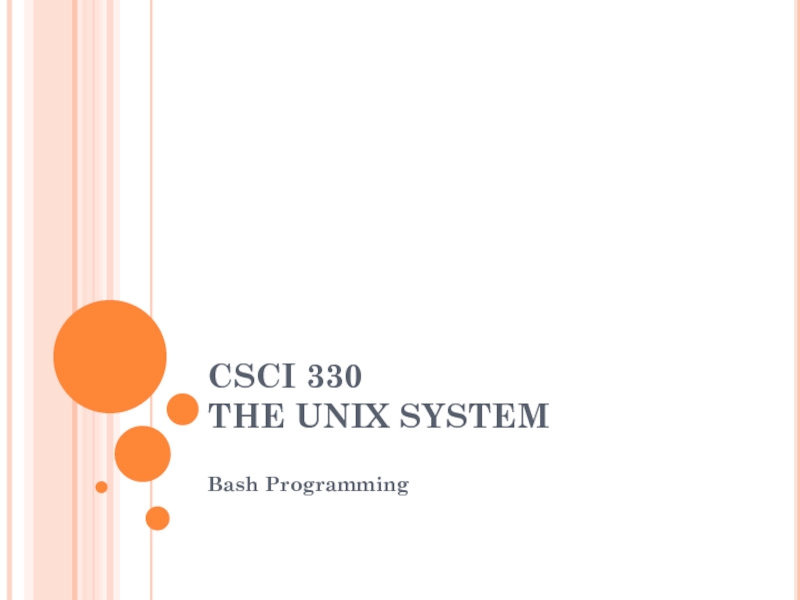
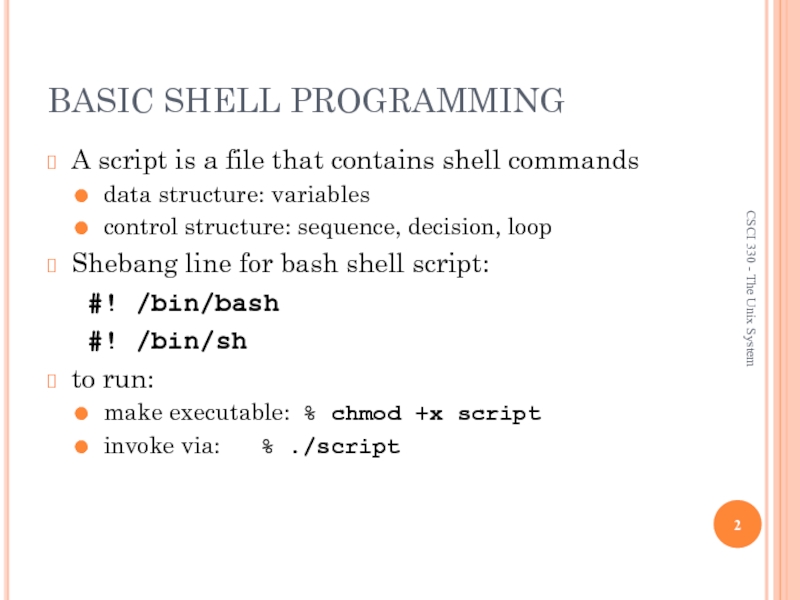

![USER INPUTshell allows to prompt for user inputSyntax:read varname [more vars]orread –p](/img/tmb/4/324362/4da181e4134c717b05f57de4fff960b9-800x.jpg)
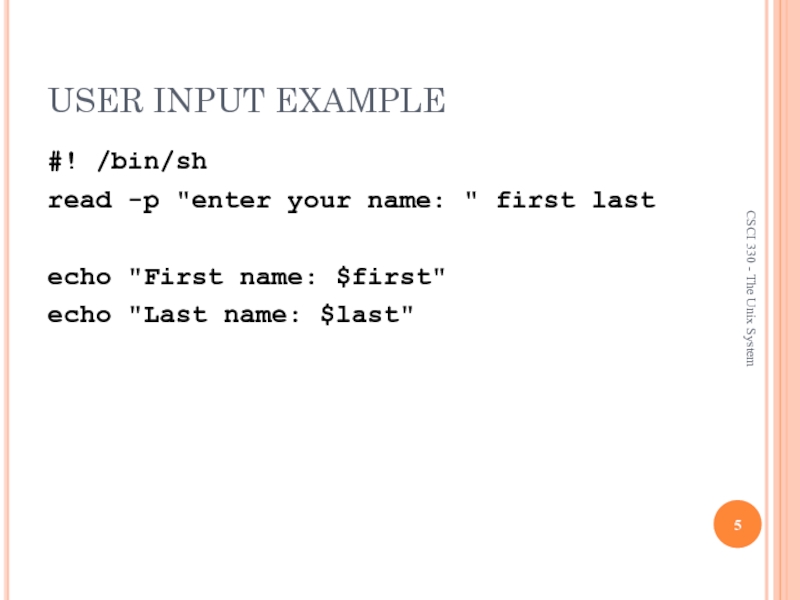
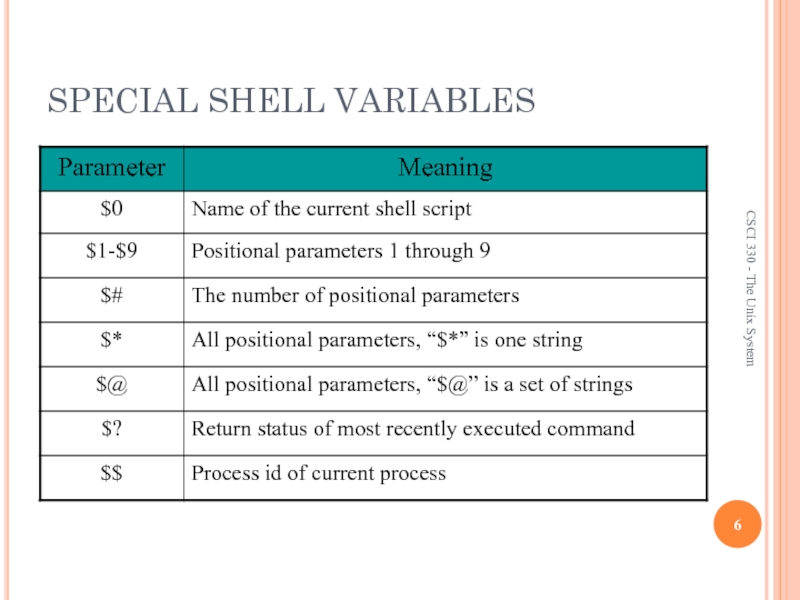
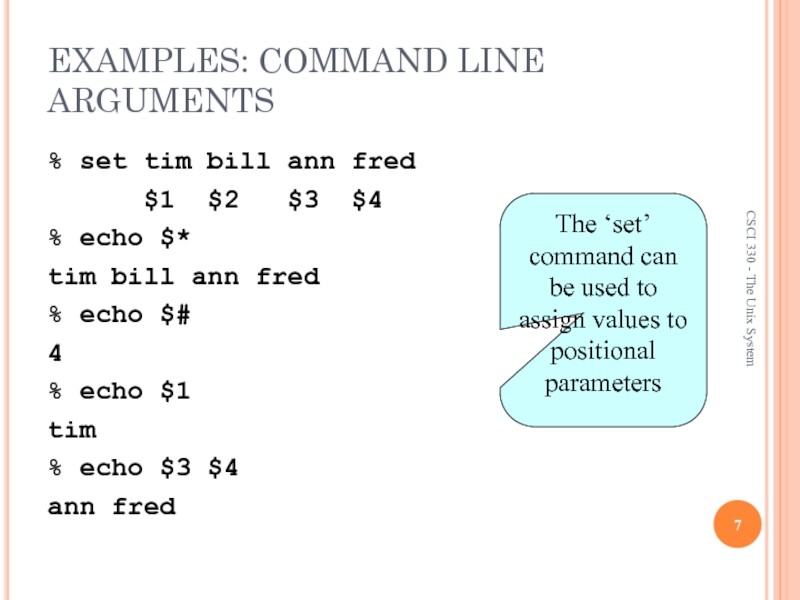


![TEST COMMANDSyntax: test expression [ expression ]evaluates ‘expression’ and returns true or falseExample: if test –w](/img/tmb/4/324362/853bb3251cd3ee1f04154ea7eb045f71-800x.jpg)
![THE SIMPLE IF STATEMENTif [ condition ]; then statementsfiexecutes the statements only if condition is trueCSCI](/img/tmb/4/324362/5011d742d0d849537772bbfa5665673b-800x.jpg)
![THE IF-THEN-ELSE STATEMENTif [ condition ]; then statements-1else statements-2fiexecutes statements-1 if condition is trueexecutes statements-2 if](/img/tmb/4/324362/62884e4167008d7e82e1d9e7b0fd3c93-800x.jpg)
![THE IF…STATEMENTif [ condition ]; then statementselif [ condition ]; then statementelse statements fiThe](/img/tmb/4/324362/7b0a77f66037a2d36d1e8600f1a0dd70-800x.jpg)
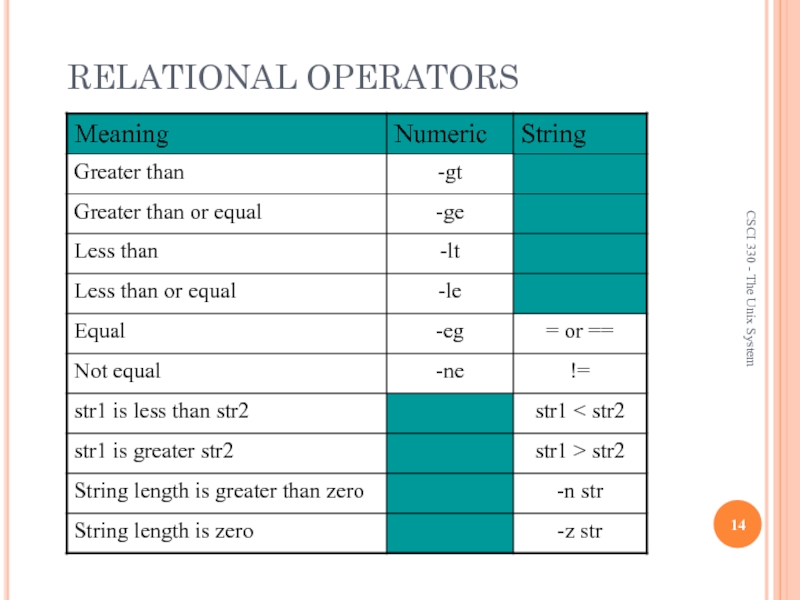
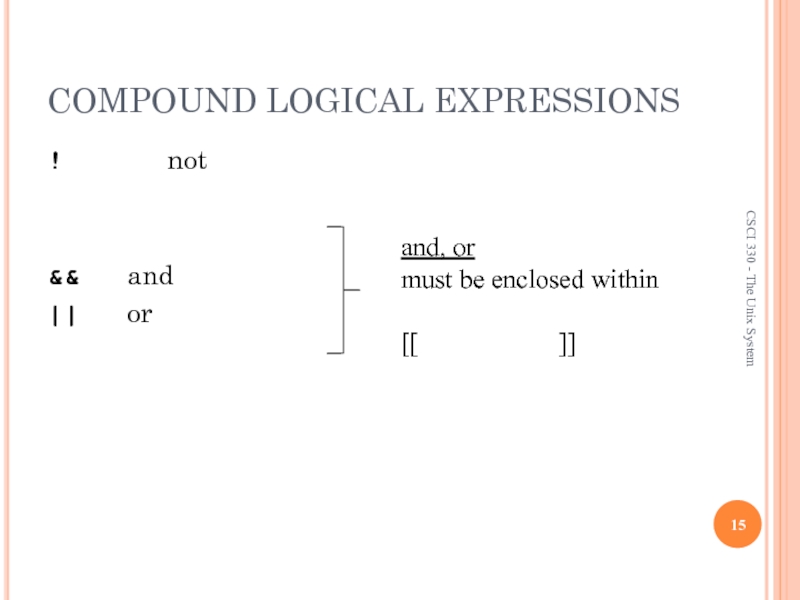
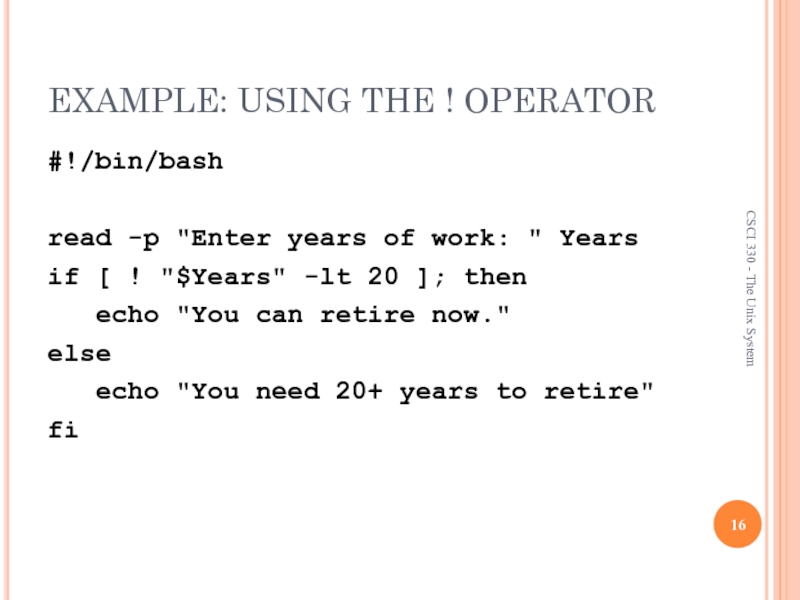
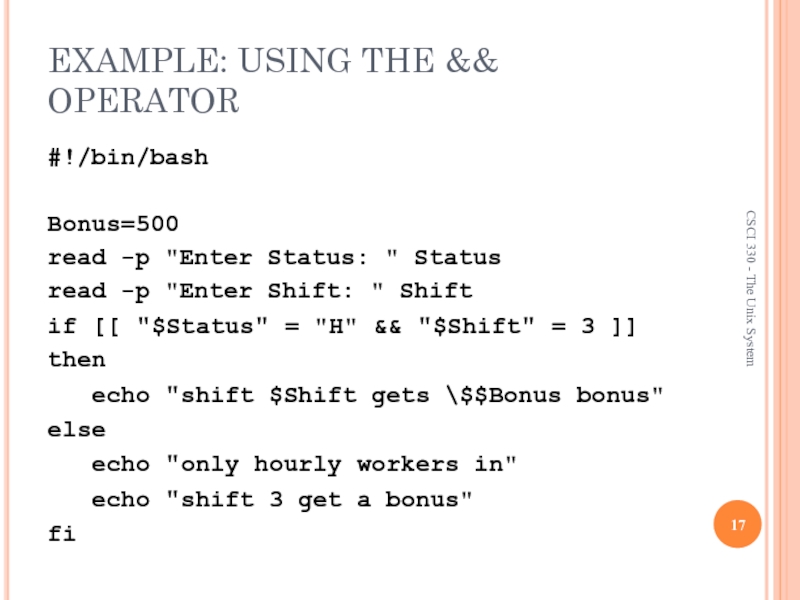
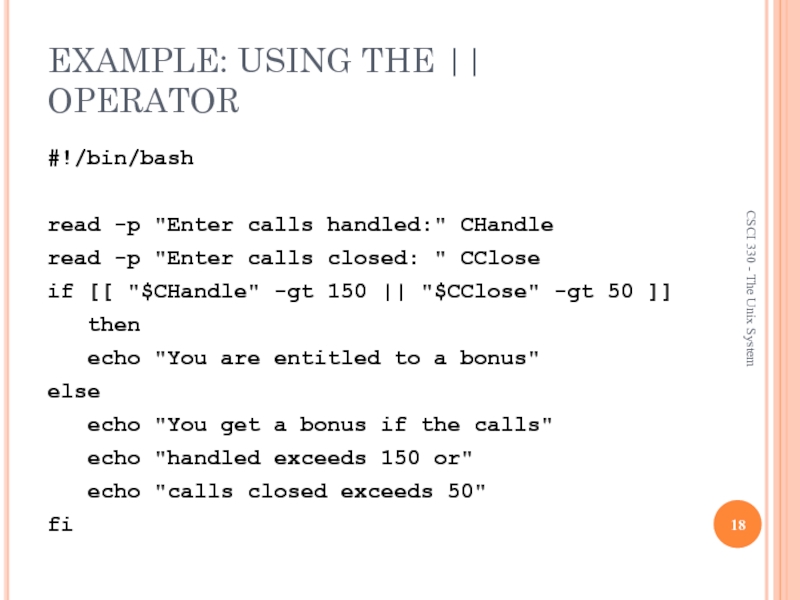
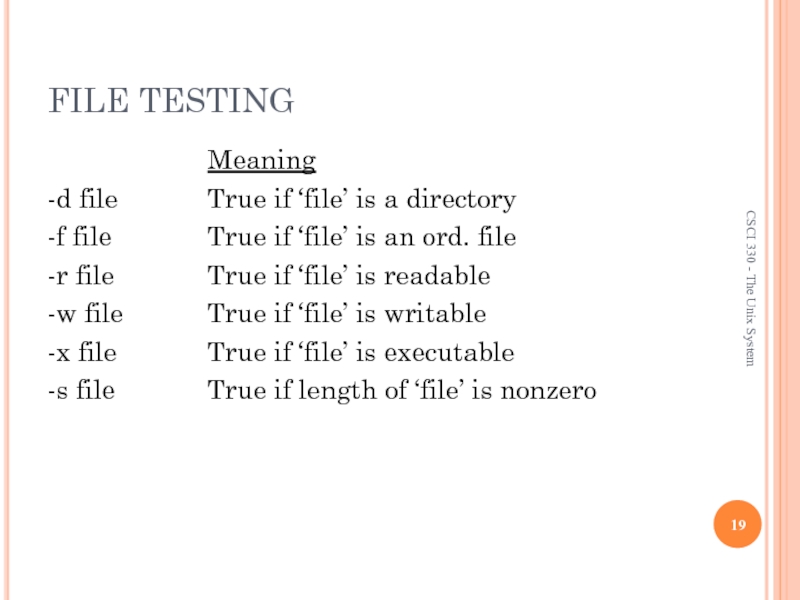
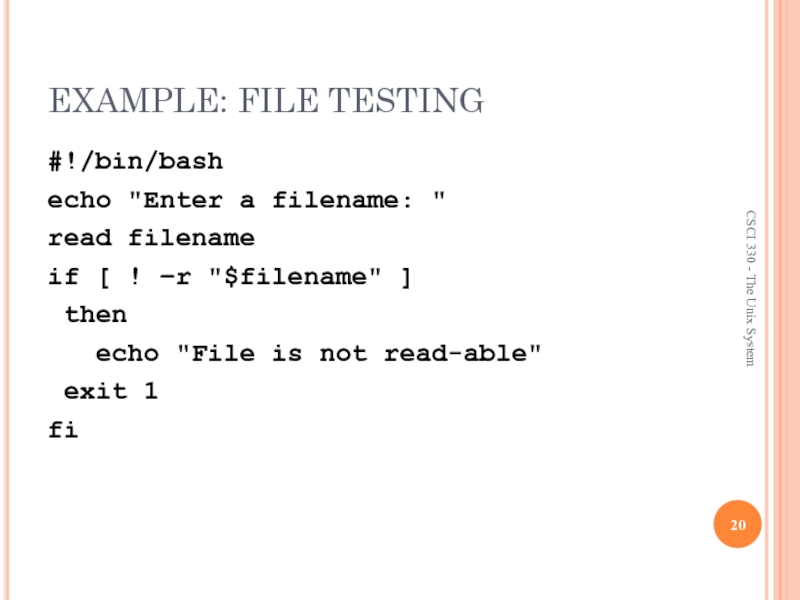
![EXAMPLE: FILE TESTING#! /bin/bashif [ $# -lt 1 ]; then echo](/img/tmb/4/324362/ee976ba083131931b1a1b838d9d6ebe5-800x.jpg)
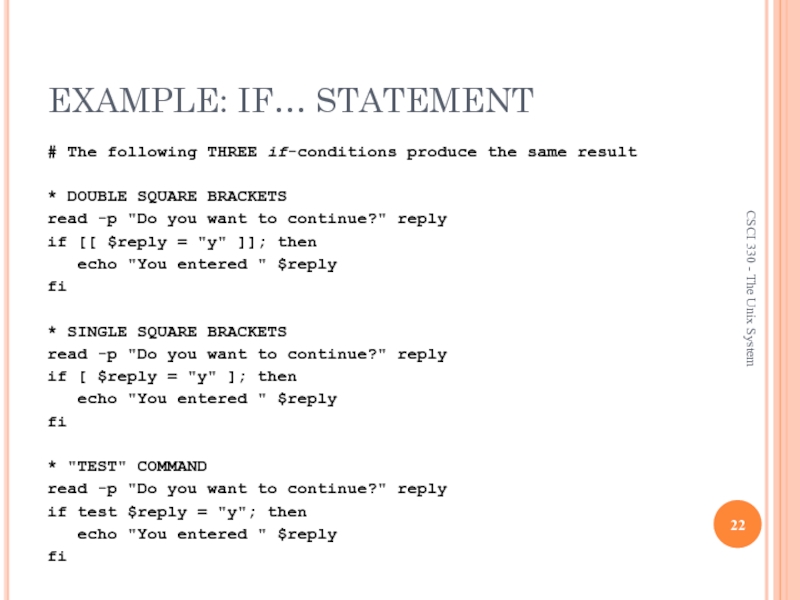
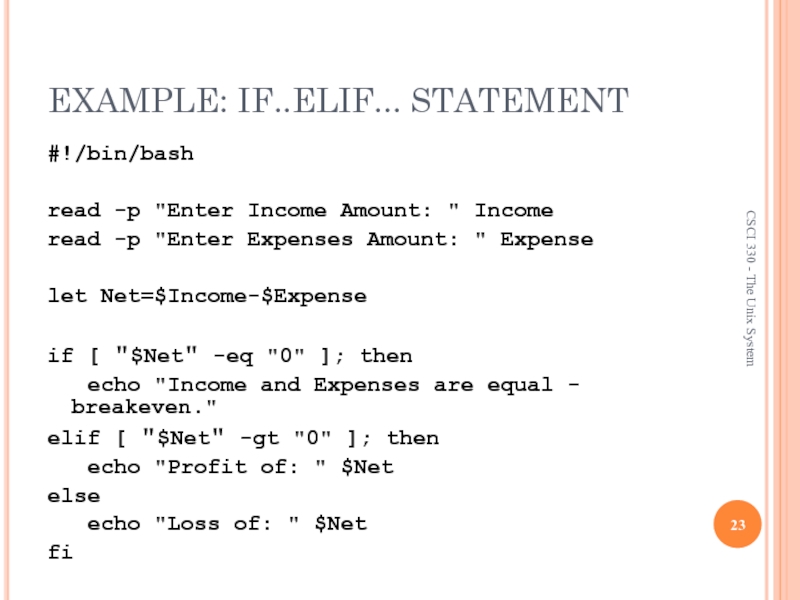
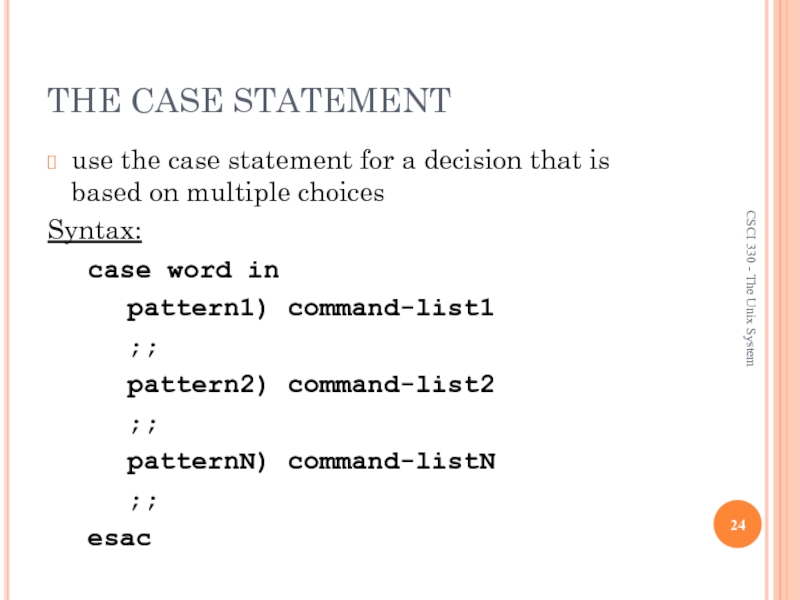
![CASE PATTERNchecked against word for matchmay also contain: * ? [ … ] [:class:]multiple patterns can be listed via: |CSCI](/img/tmb/4/324362/125403c62d4bd975020c2e0226a80b3b-800x.jpg)
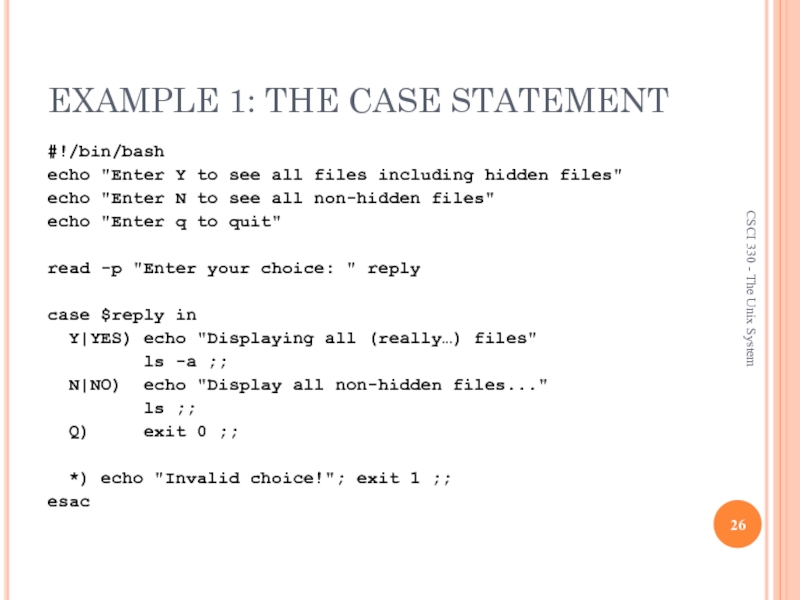

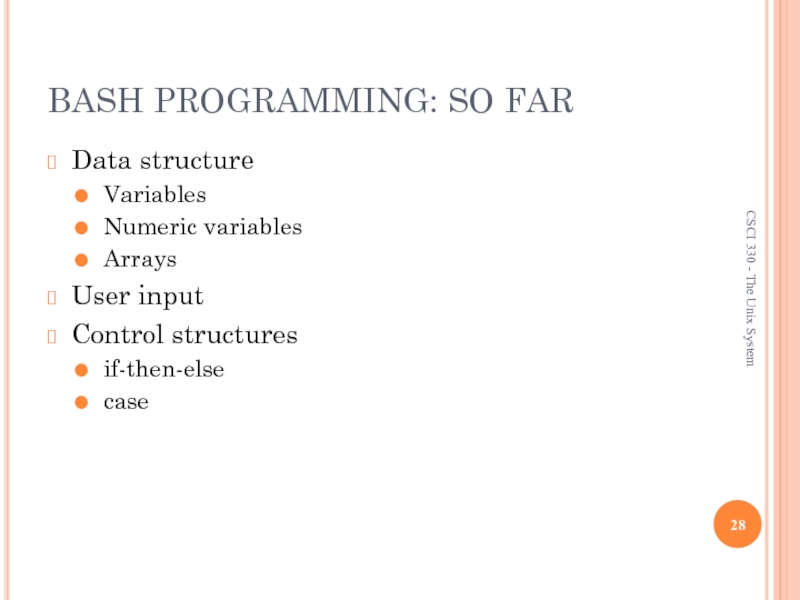
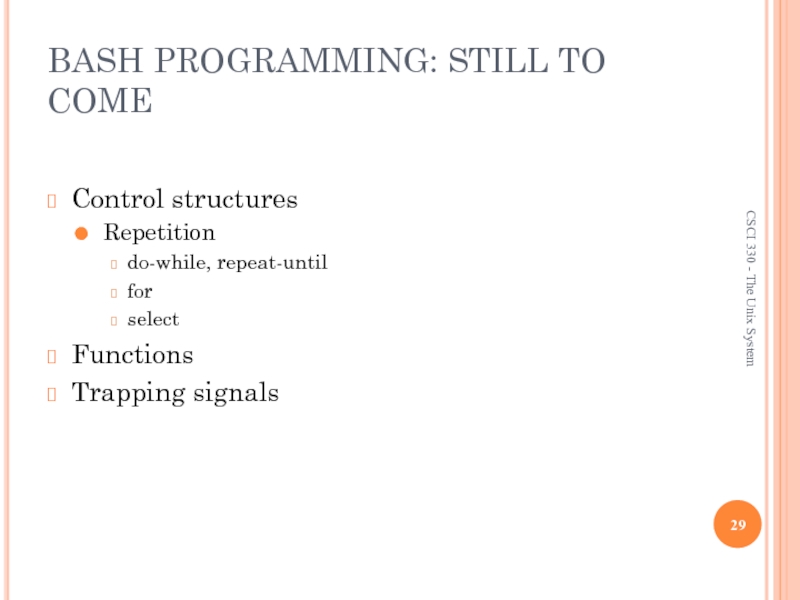
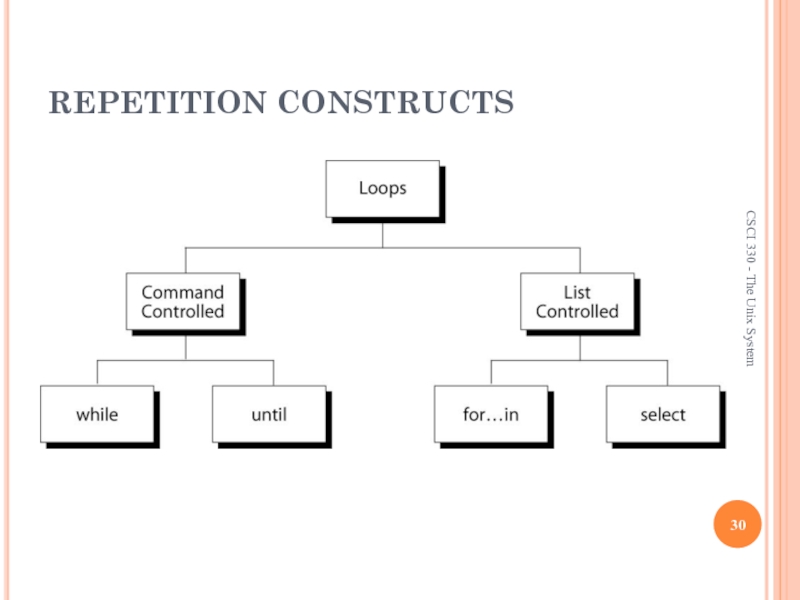

![EXAMPLE: USING THE WHILE LOOP#!/bin/bash COUNTER=0 while [ $COUNTER -lt 10 ] do echo](/img/tmb/4/324362/8f514da6c6e169c982ed0a634fac5c5f-800x.jpg)
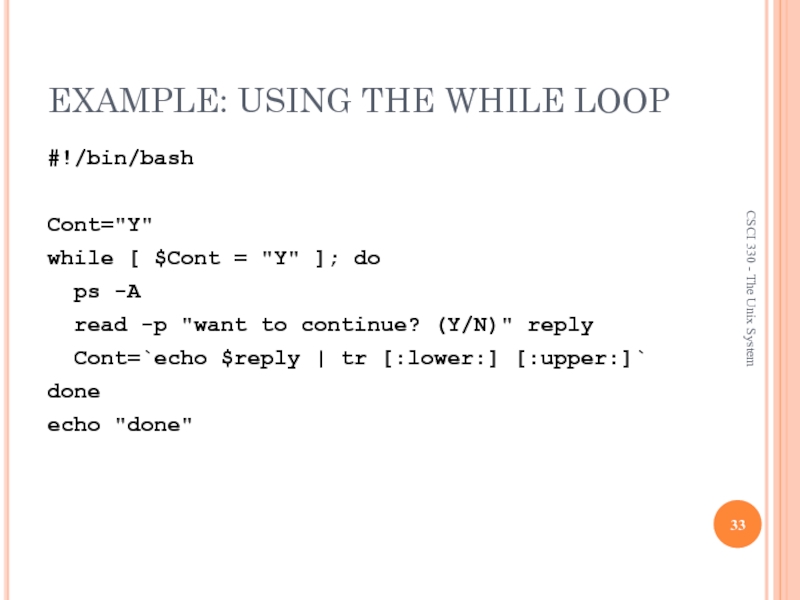
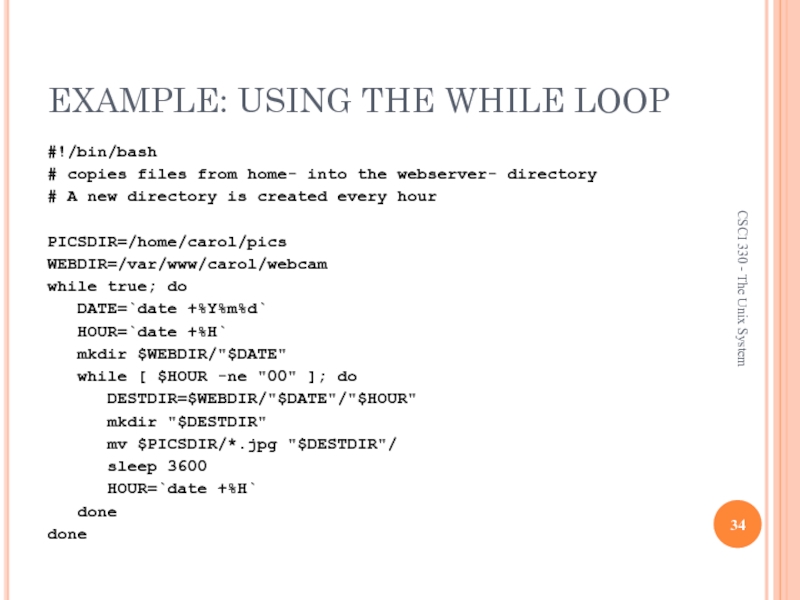
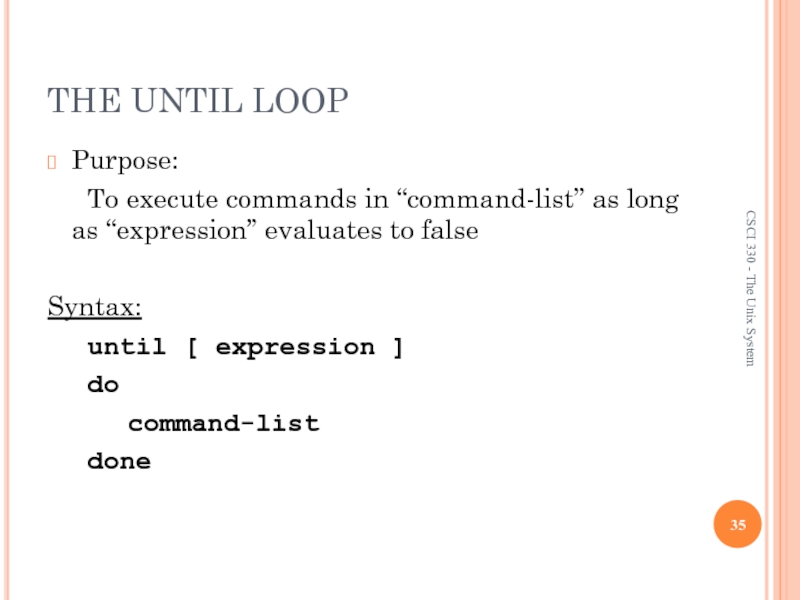
![EXAMPLE: USING THE UNTIL LOOP#!/bin/bash COUNTER=20 until [ $COUNTER -lt 10 ] do echo](/img/tmb/4/324362/1b2c45530eb7c3735a7098ee08899ac3-800x.jpg)
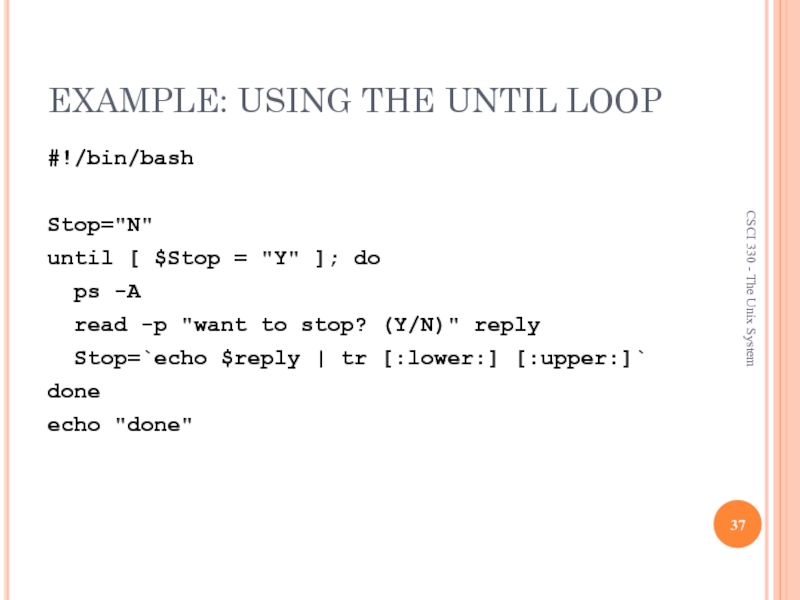
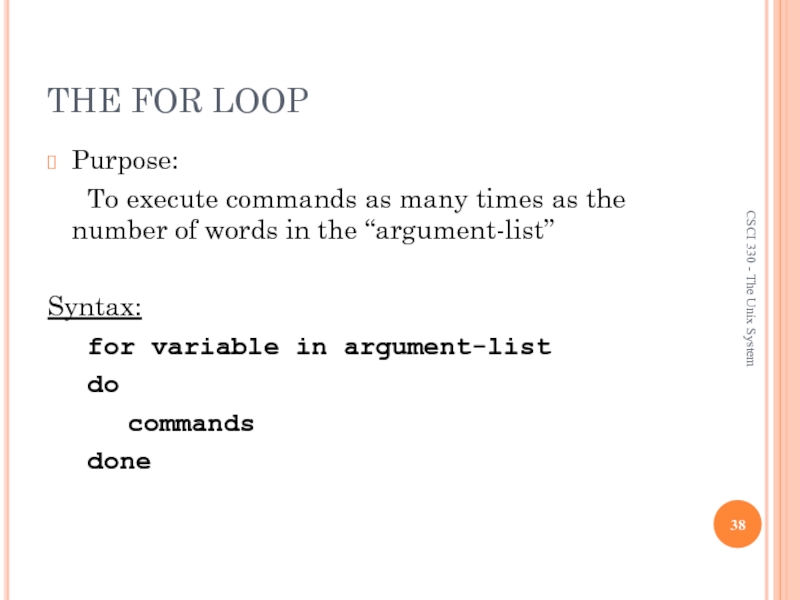



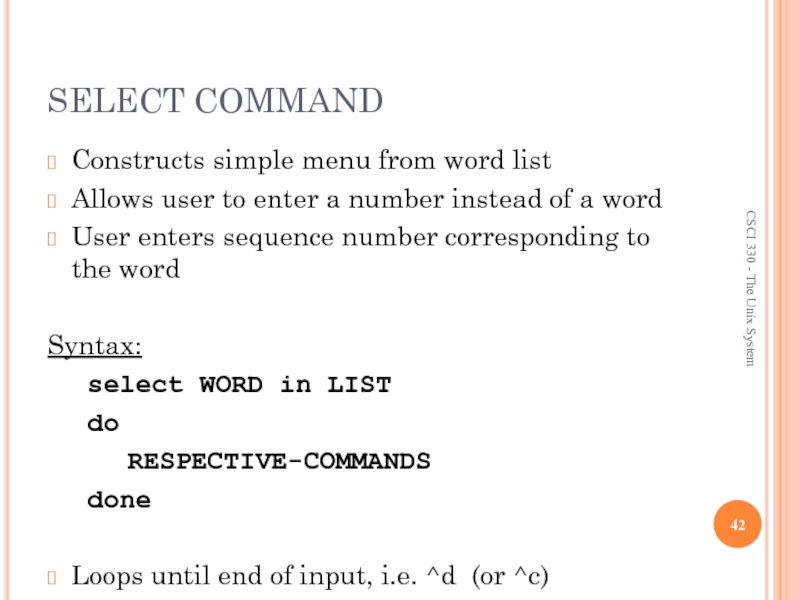
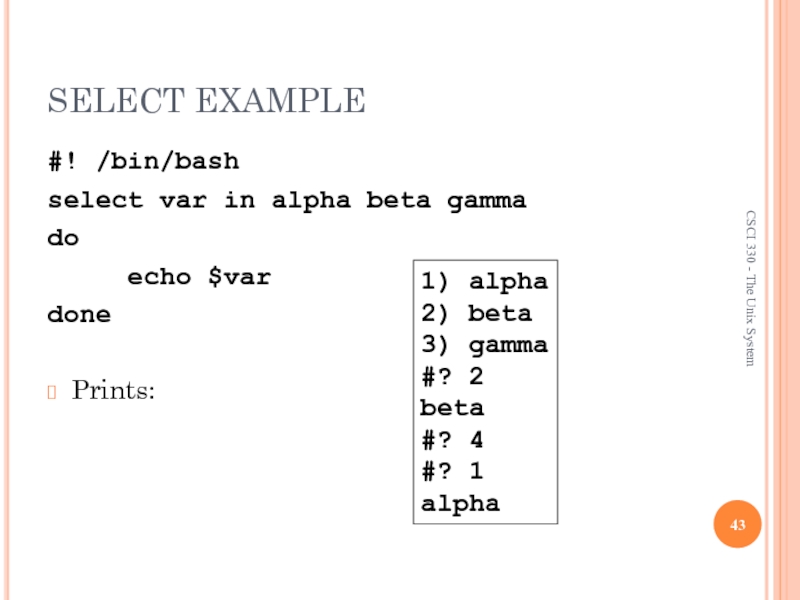

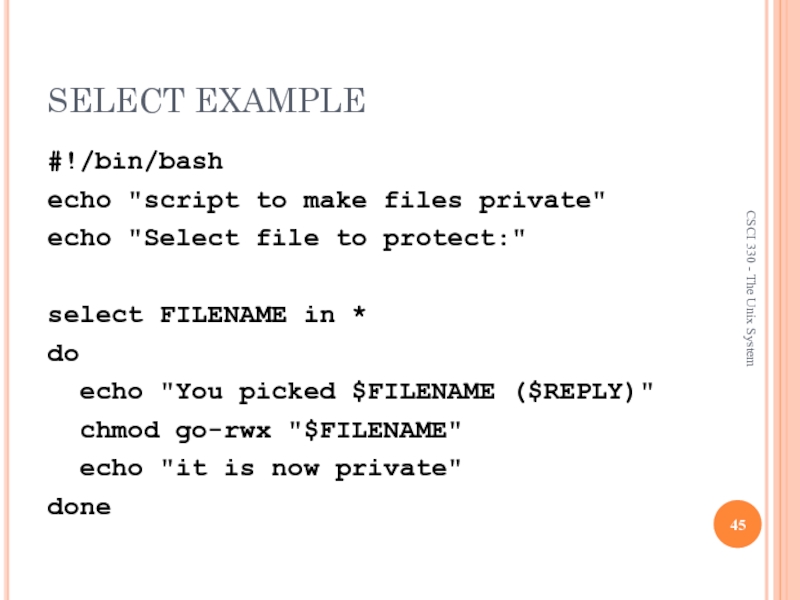
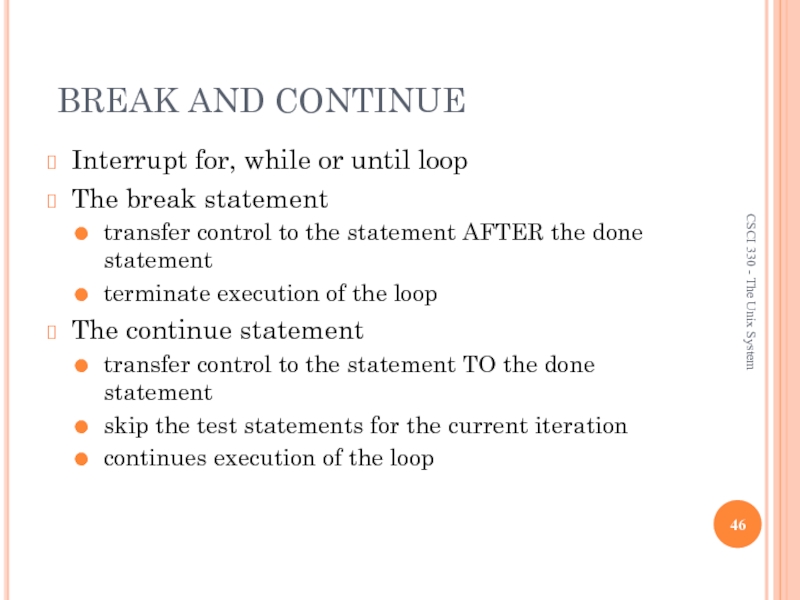
![THE BREAK COMMANDwhile [ condition ]do cmd-1 break cmd-ndoneecho](/img/tmb/4/324362/c49328c6977a62c1d7a841f1f41bc464-800x.jpg)
![THE CONTINUE COMMANDwhile [ condition ]do cmd-1 continue cmd-ndoneecho](/img/tmb/4/324362/438211777127644a1576cfe412f25fe9-800x.jpg)
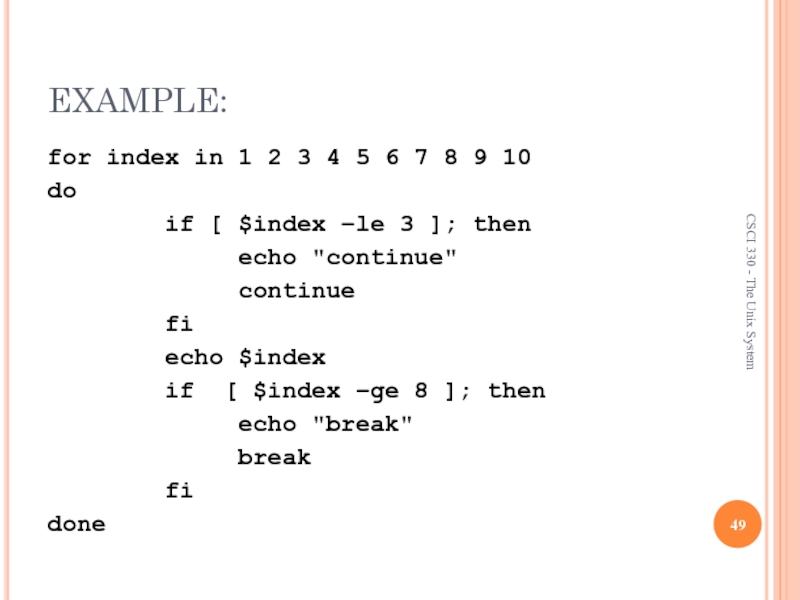
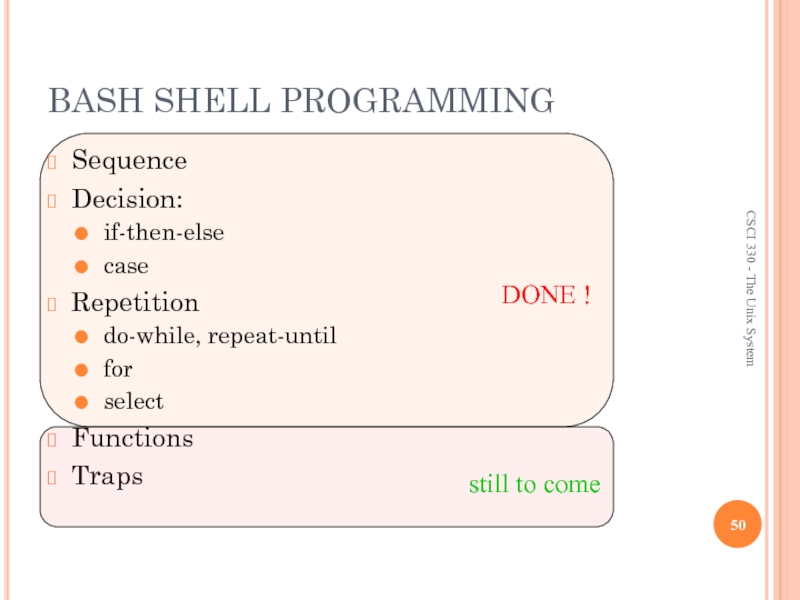
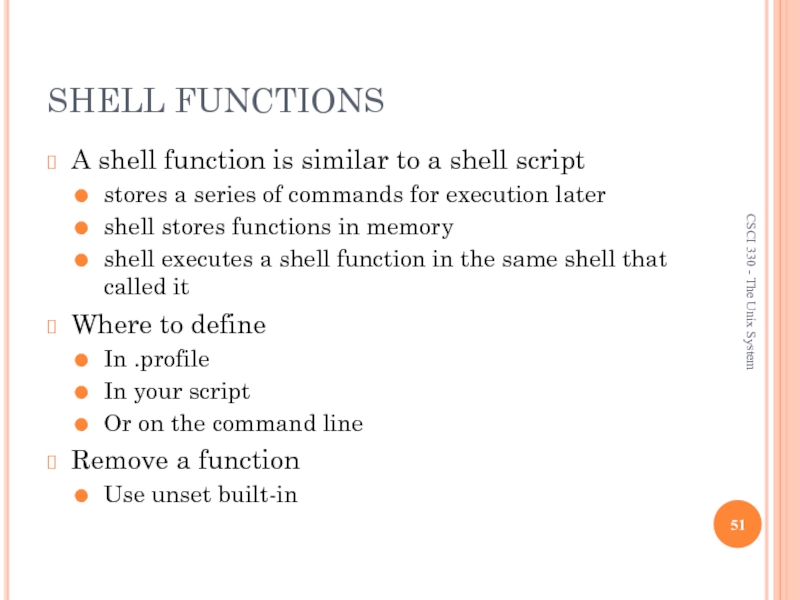
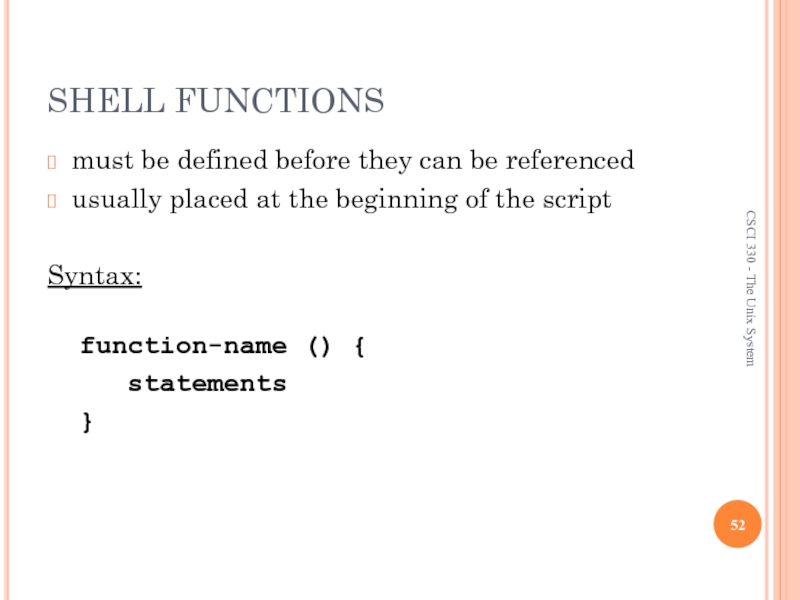
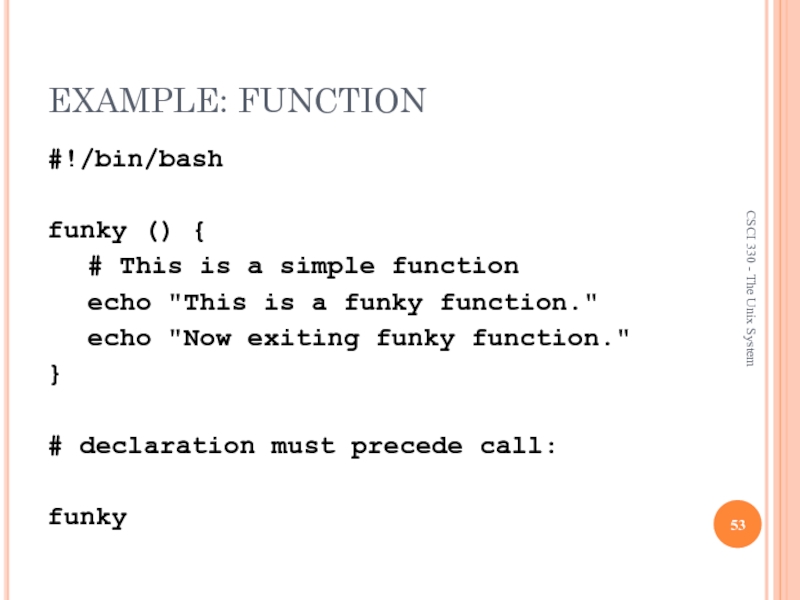
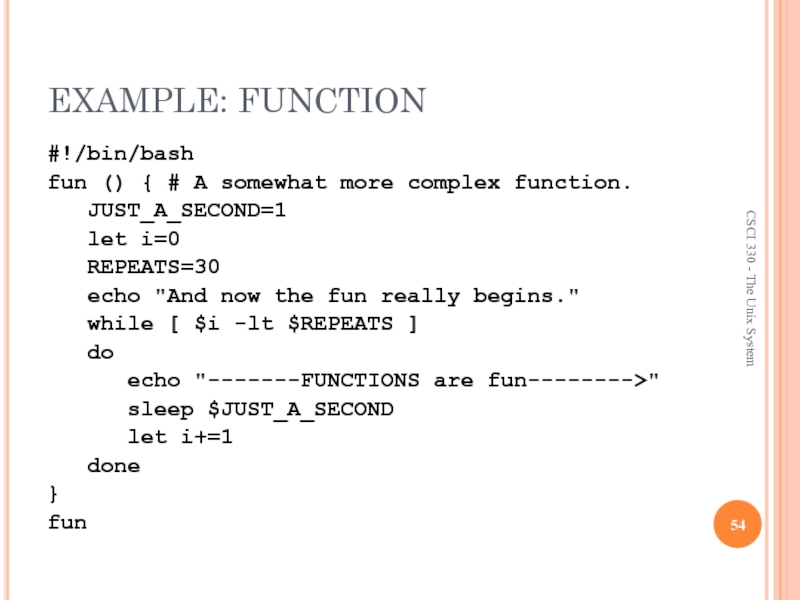
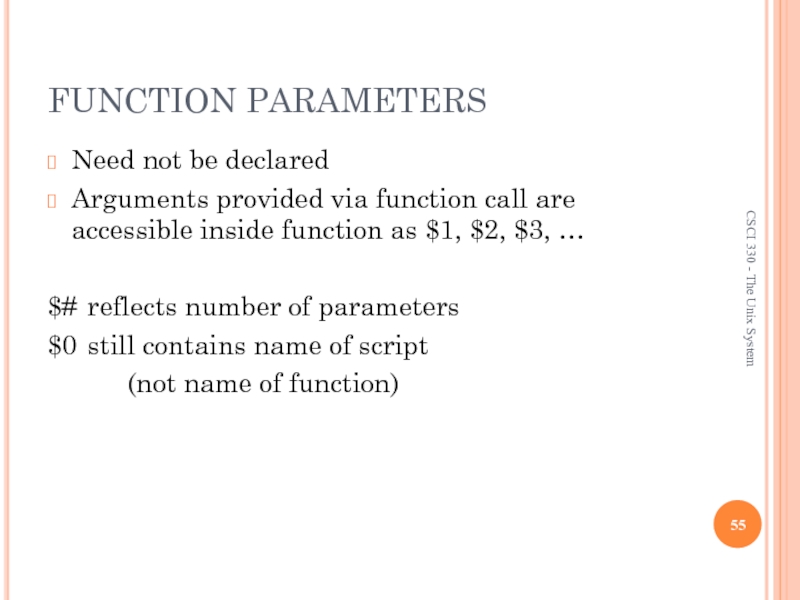
![EXAMPLE: FUNCTION WITH PARAMETER#! /bin/shtestfile() { if [ $# -gt 0 ]; then if](/img/tmb/4/324362/3bce08334496f8d1f7431a0404f17969-800x.jpg)

